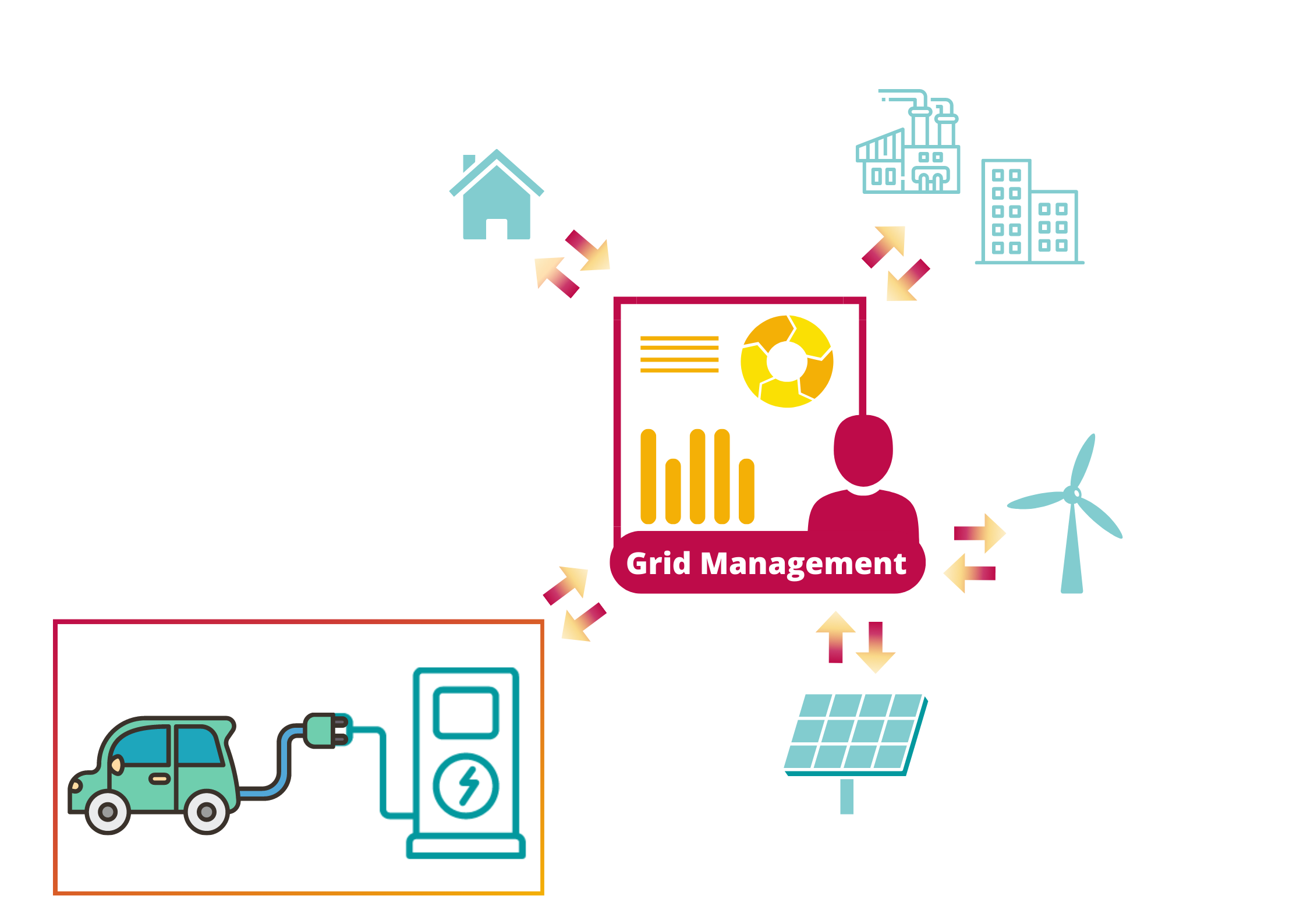The ISO 15118-20 standard, published in April 2022, extends the ISO 15118-2 standard released in 2014. In addition to improving the functionalities covered by ISO 15118-2 (AC and DC charging, Plug and Charge, Smart Charging), ISO 15118-20 expands the range of possibilities and use cases by specifying bidirectional, wireless and pantograph charging. As a member of the ISO/TC22/SC31 committee, Trialog contributed to the elaboration of this new version of the ISO 15118 protocol.
This new version brings the following features:
- Bidirectional charging (BPT): the ability to charge and discharge a vehicle.
- Dynamic and scheduled load profiles: profiles can be calculated locally or provided by an external system.
- Wireless charging (WPT): the definition of messages to exchange the necessary information between the vehicle and the wireless charger as a supplement of the IEC 61980 protocol.
- Communication multiplexing: the opening of parallel communication channels; the main channel manages the charging session. These channels make it possible to renegotiate schedules, but not services, as defined in ISO15118. They also provide the ability to send metering data without disturbing the current charging session.
- Automated Connection Device (ACD): an automatic connection and disconnection process for energy transfer by conduction. A typical example is that of the pantograph for an electric bus.
- Improved security: up-to-date cryptography algorithms.
- Management of multiple contracts: an explicit method for installing several Plug&Charge contracts in the vehicle (no method was proposed in ISO 15118-2, even if it is technically possible).
In this article, we will detail and comment on several of these new features.
Bidirectional charging

Bidirectional charging, also called V2X (Vehicle-to-Everything), makes the vehicle an actor in the electrical grid. It is an energy reserve and power regulator due to its onboard battery. V2X includes different uses:
- V2G (Vehicle-to-Grid): service provided to the grid (flexibility, stabilisation, etc.);
- V2H (Vehicle-to-Home): service provided to the home for self-consumption. The energy stored in the vehicle is used to power the household in case of need (blackout, peak consumption);
- V2B (Vehicle-to-Building): service provided to the building (offices, company car park, etc.). This is the principle of V2H applied on a larger scale;
- V2L (Vehicle-to-load): the vehicle becomes a source of auxiliary current (camping, works, etc.).
These four cases are the most representative but there are other variants and sub-use cases.
With a compatible car and charging station, the implementation of these use cases is now possible. To do so, new messages have been defined to exchange data related to discharging. The exchange of charging constraints (voltage, current, power) is extended with the exchange of these same values for discharging.
Specific parameters for vehicle discharge and its interaction with the grid have been added:
- Behaviour with respect to the grid: The station can either follow the instructions of the grid or generate a grid. In the first case, the grid imposes the voltage and frequency; the charging station only injects active and reactive power and helps to stabilize the grid (GridFollowing). In the second case, the charging station can control the grid voltage and frequency: it generates its own grid (GridForming).
- Metering architecture: a single meter is used to measure the different energy flows (Single Channel) or one energy meter is used for charging; a second energy meter is used for discharging (Dual Channel).
- Islanding detection mode: Islanding is the condition under which a distributed generator continues to supply power to an area even though the external utility power supply is no longer present. Islanding is dangerous to people who may not realize that a circuit is still powered, and it can prevent devices from automatically reconnecting. Conversely, without strict frequency control, the balance between the load and generation in the islanded circuit can be violated, resulting in abnormal frequencies and voltage. For these reasons, distributed generators must detect islanding and immediately disconnect from the circuit; this is called anti-islanding. In the event of network islanding, the vehicle/charging station system can maintain this situation. To react correctly to grid disturbances, the vehicle must know whether the islanding detection is Active or Passive.
In most cases, we want to stop the system quickly in case of a network outage using anti-islanding tools for security purposes. In other cases, we will attempt to set up islanding controlled by an Energy Management System (EMS). The EMS will then detect the phenomenon, manage islanding, and control the charging station and other local network equipment (stationary storage, photovoltaic panels, etc.). The vehicle/charging station pair is then either in the GridFollowing mode (the network is generated by the stationary storage and the vehicle and at the charging station participate in stabilisation) or in GridForming mode.
Bidirectional charging is by far the most important feature brought by ISO 15118-20, and it will drive the adoption of this version of the standard.
There are alternatives to bidirectional charging (CHAdeMO or the clever use of DIN 70121 or ISO 15118-2); however, ISO 15118-20 remains the only standard that can transfer all the information required for the variety of bidirectional charging use cases.
Improved security

Updated security requirements are included in ISO 15118-20. Firstly, vehicle-station communication must now be encrypted at all times using TLS v1.3 with mutual authentication (the client AND the server check the certificate chain used). Additionally, vulnerable encryption and hash algorithms have been removed. Furthermore, the concept of crypto-agility is introduced. The encryption, hash and key generation algorithms are configurable. If a vulnerability is discovered in one of the algorithms, it will be possible to change it by altering the configuration of the system with no impact on the interoperability of the equipment.
Cybersecurity becomes critical for ISO15118-20 since TLS is now mandatory. In addition, we must store the same contract in ISO 15118-2 format and in ISO 15118-20 format, which has an impact on the memory.
The challenge of interoperability
The deployment of ISO 15118-20, like the deployments of DIN 70121 and ISO 15118-2, raises interoperability issues. The experience acquired by electromobility players since 2012 will make it possible to address these issues with more maturity and serenity. During the system validation phase, efforts must be focused on the following points:
- Messaging and encoding/decoding: the defined messages replace those of ISO 15118-2, which breaks backward compatibility. To ensure interoperability, it will therefore be necessary to deploy ISO 15118-20 while maintaining ISO 15118-2 in stations and vehicles. Since a new set of messages has been defined, it is necessary to manage their encoding and decoding. Previously, an open-source EXI encoder/decoder was available and was widely used. Currently, several proprietary encoders/decoders have been implemented, which is a significant risk for system interoperability.
- Crypto-agility mechanism: if a flaw is discovered in a used algorithm, it must be deactivated and replaced according to the procedures defined by the standard. If the two methods provided for by the standard are not present on the vehicle and at the charging station, we may encounter a situation where they cannot communicate. This evolution is necessary to preserve the robustness of the systems over time.
- Communication encryption: mandatory communication in TLS v1.3 imposes cohabitation of TLS versions. If the equipment wants to continue to support PnC in ISO 15118-2, TLS v1.2 and TLS v1.3 must be present, and backward compatibility requirements must be respected.
Trialog’s expertise
Trialog has supported many players in the electric mobility field for approximately ten years by helping with their demos and industrial projects and/or helping to accelerate their deployment of ISO 15118. To do this, Trialog has multiple implementations of ISO 15118-2 and ISO 15118-20 corresponding to various uses:
- The YaCCS library. This library manages communication on the charging station side.
- The ComboCS tool (EV version and EVSE version) integrates ISO 15118-20 to validate developments.
Trialog also offers on-demand training sessions on the ISO 15118 standard: 15118-2, 15118-20 and 15118-3.


